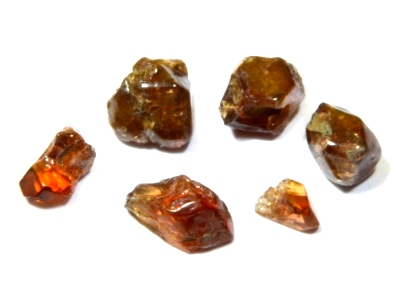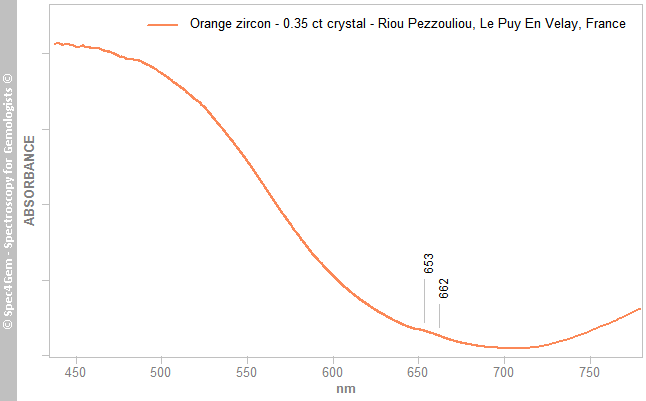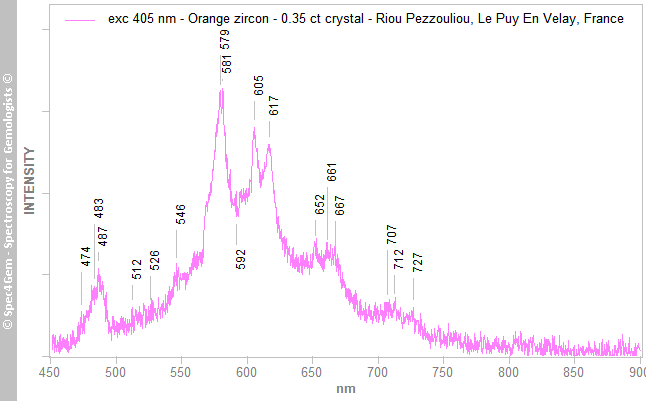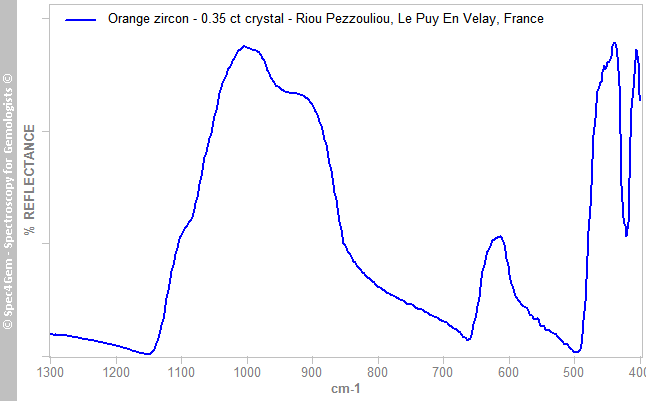Orange zircon crystal from the Riou Pezzouliou, Le Puy-En-Velay, France
- Details
- Created: Tuesday, 20 December 2016 21:38
According to Mindat.org: "The Riou Pezzouliou is a small brook which runs on the right side of the river La Borne. Well known since the Middle-Age for alluvial gem-quality sapphires and zircons. The source of the gems has not been clearly traced, but they are probably linked to magmatic enclaves in the neighbouring basaltic units".
The Riou Pezzouliou borns on the Mont Croustet, a basaltic slag strombolian cone with many crustal xenoliths. Corundum, zircon, nepheline are present in colluvium formed on the slopes of the cone.
The crystals shown in figure 1 are from the alluvial deposit and were provided by Alexandre Eichler who was sincerely thanked for his donation. The chosen zircon of this study is the crystal displayed in figure 1's foreground.
 Figure 1. Brownish-orange zircon samples from The Riou Pezzouliou,
Figure 1. Brownish-orange zircon samples from The Riou Pezzouliou,the crystal in the foreground is the sample studied in this report.
| Shape | part of a tetragonal crystal |
| Size | 4.9 x 2.8 x 2.2 mm |
| Color | orange (slightly brownish) |
| Lustre | vitreous |
| Weight | 0.35 ct |
| SG | ~ 4.33 |
| RI | - |
| DR | - |
| Pleochroism | none observed |
| Polariscope / Conoscope | light/dark 4 times / 360°, uniaxial |
| SWUV | inert |
| LWUV | inert |
| Magnetic susceptibility | inert with the N52 magnet |
Table 1. Observational and measured properties
Infrared reflectance spectroscopy:
The IR reflectance spectrum of the sample shown in figure 2 was acquired from a face of the crystal. It gives an unambiguous spectrum which is characteristic of zircon mineral.
UV-VIS-NIR spectroscopy:
The UV-Vis spectrum (figure 3) was acquired without taking care about light polarization, the light path passed through the stone from its top to its bottom as seen in figure 1. A significant continuous increase of the absorption intensity toward the UV over the entire visible range causes the brownish-orange coloration of the zircon sample, especially with the slope due to the band located around 520 nm. Although the U4+ absorption features at 653 and 662 nm are so weak, they can be easily distinguished while zooming in the spectrum.
 Figure 3. The UV-Vis spectrum of the sample shows the typical spectrum pattern of the orange / brown zircons. The U4+ absorption features at 653 and 662 nm are really weak but strong enough to be distinguished.
Figure 3. The UV-Vis spectrum of the sample shows the typical spectrum pattern of the orange / brown zircons. The U4+ absorption features at 653 and 662 nm are really weak but strong enough to be distinguished.Photoluminescence spectroscopy:
The photoluminescence spectrum (figure 4) was acquired with a 405 nm laser but no luminescence was observed with the naked eye. Whilst the spectrum signal is very low, the REE common emission peaks are well defined and distinct.
 Figure 4. The sample's photoluminescence spectrum excited at 405 nm, shows a typical emission attributed to the REE3+. Only one U4+ re-absorption band is observed at 592 nm even it is not confirmed. The other particularity is the possible UO22+ emissions at 512 and 526 nm.
Figure 4. The sample's photoluminescence spectrum excited at 405 nm, shows a typical emission attributed to the REE3+. Only one U4+ re-absorption band is observed at 592 nm even it is not confirmed. The other particularity is the possible UO22+ emissions at 512 and 526 nm.The spectrum is dominated by the REE3+ emissions and shows two others singularities. The 592 nm U4+ re-absorption band is quite weak and it is bordered by two much stronger emissions, its detection is not obvious. This is the only one visible in the whole spectrum, the 655 and 692 nm ones are not observed. The spectrum shows two weak features at 512 and 526 nm that can be assigned to UO22+, due to the weakness of the features, they should be carefully considered.
The spectrum features can be ascribed as follows, Gaft et al.[1]:
- 474, 483, 487: Dy3+
- 512, 526: UO22+
- 546: Er3+
- 579, 581: Dy3+
- 592: U4+ re-absorption
- 605, 617: Sm3+
- 652, 661, 667: Sm3+
- 712, 707, 727: Sm3+
Conclusion:
Zircons found in The Riou Pezzouliou brook contain U4+ and some REE3+ as Dy3+, Sm3+, Er3+ and possibly the UO22+ uranyl ion. The zircon's color causes are still being studied and subject to discussions, this brownish-orange could be the result of an electron or hole center as for the red zircon.


